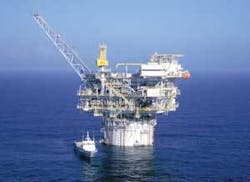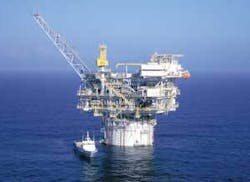Deeper water. More complicated logistics. Greater technical complexities.
These are but a few of the challenges facing the offshore segment of the oil and gas industry as they seek new energy reserves to satisfy burgeoning worldwide demand.
While alarmists have been warning us for more than 25 years that “the world is running out of oil,” several realities in recent history have refocused global attention on the precarious balance between energy supply and demand. In 2005, a combination of political conflict in key production regions, a record setting Atlantic hurricane season, and brisk expansion in some of the world’s newest economic powerhouses drove prices for both crude oil and natural gas to unprecedented levels.
In a presentation titled Today’s Energy Reality: We Are In A Deep Hole, energy investment banker Matthew R. Simmons outlined the situation last October for members of the Independent Petroleum Association of America (IPAA). Three of the biggest causes for concern, Simmons said, are (1) the unexpectedly rapid growth in global energy demand - particularly in China and India, (2) the slowing pace of new energy reserve discoveries, and (3) the revelation that many “proven reserve” estimates were illusory. Estimating that worldwide energy demand will reach nearly 150 million barrels per day of oil equivalent by the year 2020 (up from a current 84 mb/doe), Simmons observed that increased production will be required from a combination of conventional, unconventional and “conceptual” energy sources.
Another viewpoint on the world situation came from the U.S. Energy Information Administration (EIA) in a report released in mid-December.
“The oil is there,” EIA head Guy Caruso told an audience at the U.S. Department of Energy, dismissing the notion that global reserves may be peaking. “We’re not seeing the pace of investment in production that we anticipated a year ago, but we don’t envision a scenario to indicate that today’s tight global market for oil and gas will ease in the coming decades.”
Lagging exploration investment was also a cause for concern cited in the 2005 World Energy Outlook report released late in the year by the International Energy Agency (IEA). Sufficient oil and gas reserves exist, the agency said, but about $20 trillion in new investments are urgently needed to bring those supplies to the consumer market.
Where are the most promising horizons for new developments to feed the demand?
Offshore.
Deeper Water: Deeper Pockets
According to the World Deepwater Market Forecast prepared late last year by offshore analysts Douglas-Westwood, the deepwater sector is forecast to continue its growth trend and will remain strong over the next five years, reaching an annual total of over $20 billion by 2010. Douglas-Westwood managing director John Westwood predicts that the ‘Golden Triangle’ of deepwater, namely the Africa, the Gulf of Mexico and Brazilian areas, will still account for 85% of global deepwater expenditure over the forecast period, but the rapid emergence of Asia as a significant deepwater region should not be overlooked.
A charter member of the Society of Underwater Technology (SUT), Westwood’s technical background is in underwater electronics. His experience in diving and manned submersibles includes collaboration with Jacques Cousteau’s team. Now acknowledged as one of the world’s leading offshore analysts, he is credited with the introduction of remotely operated vehicles (ROVs) into the North Sea oil industry.
“After the drilling and completion of subsea wells, an activity that is becoming increasingly expensive in areas such as the Gulf of Mexico, it is floating platforms that form the main component of deepwater development expenditure,” Westwood said. “Advances in technology, particularly in mooring systems and innovative hull designs, are allowing production from greater water depths to be viable on both a technical and economic basis.”
The consensus among analysts is that West Africa will remain at the forefront of deepwater development. Activity in the region has been strong in recent years and promises to continue in that vein in the foreseeable future. In fact, West Africa accounted for 51% of the deepwater market in 2005, and that number is expected to grow to 75% by 2008.
Because of the enormous investment required to bring offshore production to market, new discoveries are increasingly being connected - or “tied back” - to existing gathering, transportation and processing facilities to maximize the useful life of existing production infrastructure. These subsea tiebacks improve economic returns by facilitating the expansion of logistical networks over greater distances and into deeper waters. They also often result in the transformation of marginally productive fields into profitable assets.
The rapid growth in application of subsea tiebacks has, in fact, has led to increased dialogue among operators, field engineers, project managers and equipment suppliers as they share information on techniques and technology for meeting new challenges. The latest gathering of specialists in the field is the sixth annual Subsea Tieback Forum scheduled February 28 - March 2, 2006 in Galveston, Texas. This conference and trade show is designed to explore the latest technical and operations innovations, with particular emphasis on design, flow assurance and installation issues. With more than 1,000 conference delegates and over 75 trade show exhibitors, presentations from major, independent and state-owned operators will provide insight to geopolitical and economic factors affecting subsea tiebacks around the world.
A Look Back
A booming peacetime economy following World War II sparked expansion of oil and gas exploration, but the uncertainty of underwater currents, weather forecasting, drilling technology and communications systems limited the search at that time to conventional, onshore fields. The first known offshore operator to successfully overcome these difficulties - completing a well out of sight of land in the Gulf of Mexico - was Kerr-McGee Corp., in 1947. The combination fixed platform-barge configuration used for the project was a major breakthrough and marked the beginning of the modern offshore era. By 1949, 11 producing fields had been discovered in the Gulf and 44 exploratory wells were underway.
Fast forward to the late 1980s when Placid Oil Company (now a part of Oxy U.S.A.) brought the first deepwater subsea production system onstream with its Green Canyon project in 1,462 feet of Gulf water. Although the technology has improved dramatically since then, this was the real starting point of the debate about the relative merits of “wet” (subsea) vs. “dry” (above the water) production systems. While both sides of the argument have their obvious pros and cons, it seems that - despite generally higher upfront costs - the dry side continues to hold the lead.

